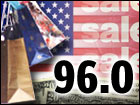
NEW YORK (CNN/Money) -
A closely watched measure of consumer confidence rose in early May, according to a published report Friday, pointing to ongoing strength in consumer spending as the economy recovers from its first recession in a decade.
The University of Michigan's preliminary consumer sentiment index rose to 96.0 in May from 93.0 in April, according to a Reuters report. Economists surveyed by Briefing.com expected the index to remain at 93.0 in May.
In the Michigan survey, which is available only to paying subscribers, consumers' view of the current state of the economy surged to 103.2 from 99.2 in April, while the index of consumer expectations rose to 91.3 from 89.1 in April, according to Reuters. Confidence figures are watched closely by policy-makers and economists since consumer spending fuels about two-thirds of the nation's economy.
U.S. stock prices were mixed after the report. Treasury bond prices fell sharply -- pushing up bond market interest rates, which move inversely to prices -- as bond investors worried the strength in consumer sentiment might mean faster economic growth, and higher inflation and interest rates, ahead.
The future of consumer sentiment will depend in large measure on the strength of the labor market. Unemployment has risen in recent months, even though many economists have already declared the end of a recession that began in March 2001. This usually happens early in an economic recovery because businesses are slow to hire workers until they're sure the economy is really on the mend.
But some economists worry that the period of job-market weakness could last an unusually long time, as it did after the recession of 1990-91, when unemployment kept climbing for 15 months after recovery began.
To keep consumers spending, the Federal Reserve cut its target for short-term interest rates 11 times in 2001. Fed policy-makers have left rates alone so far in 2002, and many economists think they will keep rates low until the labor market stabilizes.
Separately, the government reported the U.S. trade deficit shrank in March, as demand for imports moderated while exports rose. The Commerce Department said the March deficit narrowed to $31.6 billion, down 0.4 percent from the February trade gap of $31.8 billion, which had been the biggest in 10 months. Economists surveyed by Briefing.com expected a deficit of $32.5 billion.
Imports in March totaled $110.8 billion, up slightly from February but more than $10 billion below $121.5 billion a year earlier. Exports rose 0.6 percent to $79.2 billion.
The rise in exports was led by gains in foreign demand for commercial aircraft, American-made autos and auto parts, and computers. This more than offset the 0.3 percent rise in imports, led by a 15.7 percent jump in America's foreign oil bill, which rose to $6.8 billion.
That figure reflected a $2.62 increase in one month in the average price of a barrel of foreign crude oil, to $19.18. The jump was the biggest since a $4.45-per-barrel surge in October 1990 after Iraq invaded Kuwait.
For March, Japan reclaimed its place as the country with which the United States suffered the biggest trade deficit, an imbalance of $5.7 billion, up 0.7 percent from February. China, which has occupied the top spot for the past two years, fell back to No. 2 in March with a trade imbalance of $5.6 billion, down 13.4 percent from February.

|

